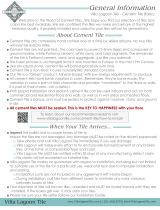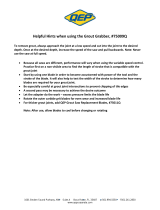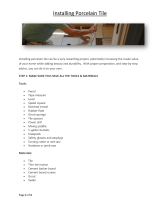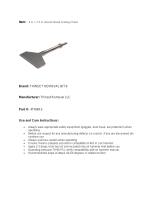
Installation
Cement Tile Preparation - Installation - Sealing
■ Surface Preparation
□ All surfaces must be solid and clean.
□ Floors – cement slab or subfloor covered with cementious board (i.e. Hardie, Durock).
□ Walls – covered with cementious board (i.e. Hardie, Durock). No regular drywall (Gypsum).
■ Layout
□ Check layout plan by laying out at least one row of your tiles dry (without adhesive) in each direction of your
intended tile orientation. You may need to shift the layout to balance the border tiles from the walls. If using
pattern tiles, make careful note of the tile's orientation.
□ Be sure to pull tiles from different boxes. This creates a more consistent floor look with out light or dark areas.
■ Setting the Tile
□ Wet the back of each tile by quickly dipping them into a bucket of water for 1-2 seconds or wetting the back
only with a sponge. Drip or wipe off any excess prior to placing in thinset.
□ Working in 2-3 square foot areas, spread the thinset mortar on the tiling surface using the 1/2” hand trowel.
□ Press the tile down firmly with your hands, DO NOT USE A HAMMER OR RUBBER MALLET. This can break the tiles.
□ Grout joints should be not larger than 1/8”.
□ Avoid getting the thinset on the surface of the tile. The thinset can stain the unsealed tile.
□ Be sure to check for alignment, and lippage on every tile.
■ Before Grouting
□ During drying, protect the tile at all times from workmen, foot traffic, ect.
□ Once the tiles are set, let stand/cure 24 hours until dry. Look for any surface dirt or dried thinset and remove
carefully with a razor blade without scratching the surface. DO NOT USE ACIDS, VINEGAR, ON CEMENT TILE. A
razor blade for scraping or med. sandpaper 150 grit is ok. Very fine sandpaper may polish instead of remove debris.
□ NOTE: A coat of a high quality sealant may be applied at this point to help prevent grout residue haze.
■ Grouting
□ Be sure the floor is completely dry before grouting. Mix the grout as directed.
□ Unsanded grout is recommended for grout joints 1/8” or less.
□ Black grout may create a dark residue on the tiles that may be difficult to remove. A medium to light color is
recommended – Regular or modified thinset may be used. Do not use epoxy grout.
□ Working in 2-3 square foot areas, spread the grout on the tile surface; then, using the grout float, move the grout at
45 degree angles to the grout lines. This ensures a smooth even grout joint.
□ Quickly clean up excess off the face of the tile using a soft sponge and clean water. Avoid pulling the grout from
the grout line by wiping at an angle to all grout lines. Be sure to get the tile surface as clean as possible.
□ Let dry/cure for minimum of 24 hours.
■ Sealant
□ Always test sealants or cleaning products on a single tile before applying to the entire floor.
□ Use a high quality penetrating/impregnating sealant. Apply as directed. Two to three coats may be required.
□ NOTE: a coat of paste wax may be applied on top of the sealant. The paste wax can help prevent staining and
provide a renewable waterproof protective layer.
□ CAUTION: Penetrating sealants cannot be used with top coat acrylic or urethane sealants
Villa Lagoon Tile
www.VillaLagoonTile.com 1.251.968.3375 info@VillaLagoonTile.com
■ Tile Wet Saw - Diamond Blade
■ Notched 1/2" Hand Trowel
■ Grout Float - Rubber
■ Tile Adhesive - Regular Thinset Mortar
■ Grout - Unsanded
■ Several Buckets & Sponges
■ Rubber Gloves
■ Safety Glasses
Equipment Needed
□ Examine the tiles when they arrive. Please note any damage
on the delivery driver's paperwork.
□ Examine each tile for damage. Set aside any damaged tiles for
later use. Damaged tiles may be used on other parts of the floor
where tiles may need to be trimmed.
□ Do not make any unnecessary pencil marks on cement tiles.
□ Cement tiles are very absorbent and can be easily be stained.
Until they are appropriately sealed, avoid walking on the raw
Tiles or handling with dirty hands.
□ Cutting the tiles – Be sure to use a wet saw with a diamond blade.
□ Adhesive mortar – regular or modified thinset may be used.
Mix as directed. We do not recommend mastic.
□ For outdoor installations or in wet areas please contact us.
■ Precautions and Hints





